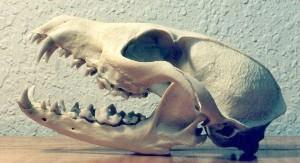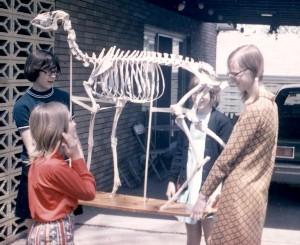
Gray fox skull
 Gray fox skull |
I had no more than a couple bones at home, although I did have small collections of fossils, minerals, feathers, and shells. I was often captivated by things I found when we were out hiking or camping, and had noticed bones before, but the first time I tried to take home part of a bleached and weathered old deer skull that I found while camping in South Dakota, I was told that it was not worth keeping. If I found other bones or skulls during subsequent years, they were just of passing interest and I thought no more about studying them. Then, when I was about 12 or 13, we were camping in Michigan and I found a small carnivore skull. I didn't know it then, but it was from a mink. The perfect symmetry of the skull and the tiny white teeth were as beautiful and fascinating to me as any fine art sculpture. It was clean, so I took it home.
Having decided to collect bones and skulls for a science exhibit, I needed to actually find some. This proved to be exceedingly easy. We often went hiking in the numerous wild areas around Lemont (which was smack dab in the middle of the Cook County Forest Preserve District, the largest such park system in the country). I had a good eye for finding things, from many years of mushroom hunting, fossil collecting, and simply observing nature. Within a few weeks, my mother, sister and I had accumulated a good selection of bones, teeth and skulls. I was familiar with how institutions number their specimens (natural history museums are another of my passions), so I carefully marked each item with a number and wrote down what it was and where it was found in a small notebook.
Learning to identify the bones was a delightful challenge. I scoured the local libraries for books that included anything about skulls and identifying the animals to which they belonged. I also used clues found with the bones, such as hair, feathers, or bits of skin. In the case of dog skeletons, there was sometimes a collar as well. With relatively little practice it became easy to classify almost any skull by its physical characteristics. From the skull, I was able to learn to recognize other bones as well. By the time I presented my science project, I had created comparative charts of the humerus bone and teeth (with real examples) of a couple dozen animals, had a collection of about 30 skulls and had, with a great deal of help from my patient mother, reconstructed a white-tailed deer skeleton. I had read all sorts of articles and sections of books relating to bones and even had a good grasp of the histology (study of tissue) of the skeletal system. This last feat was rather remarkable as I had always found cellular biology to be of little interest before this time.
 Too big to be loaded into our car, we carried the deer skeleton to school. Patricia is holding the front end and Val the back. Vicky (back) and her friend, Sheila, look on. Lemont, IL, 1972 |
During high school, I did another big science project on bones, going into far more depth than my beginning effort in grade school. I visited with one of the curators of the mammology department in the Field Museum of Natural History, who was not only impressed that I could identify a few scattered bones in a display case as belonging to a newborn fawn, but seemed so excited to find somebody else with similar interests that we talked about bone collecting for 4 hours, while he showed me some of the more interesting and exotic of their specimens in the research areas of the museum.
Even though I majored in music performance when I went to college, I certainly didn't give up any of my other interests. One of the most enjoyable electives I took was an anthropology class in osteology. Studying for tests was loads of fun as we were encouraged to look through an extensive collection of human bones, trying to memorize every single carpal and tarsal, as well as using measurements to determine sex and/or race of the skulls. Since the purpose of the course was to give students practice in recognizing and analyzing skeletal remains they might find while doing actual field work, our teacher would mix in animal bones during our weekly quizzes, for which we had to identify 20 or 30 bone fragments. I took great delight in not only recognizing the animal vs. human remains, but in being able to identify the species and sometimes even the age of the pieces. My advantage might have seemed unfair, but I was an undergrad taking a graduate course, and I really didn't have any experience with HUMAN bones before this.
Over the years, I've continued collecting skulls and other bones, putting skeletons together, and studying osteology. The intrinsic sculptural qualities of the bones, as well as their link to phylogenetics (the basis for evolutionary biology), anatomy and taxonomy (the science of naming and classifying organisms), have ensured that my interest will never wane. The A+ grade I received for that first science fair project was insignificant when compared to discovering a fascinating hobby that would entertain me for the rest of my life.